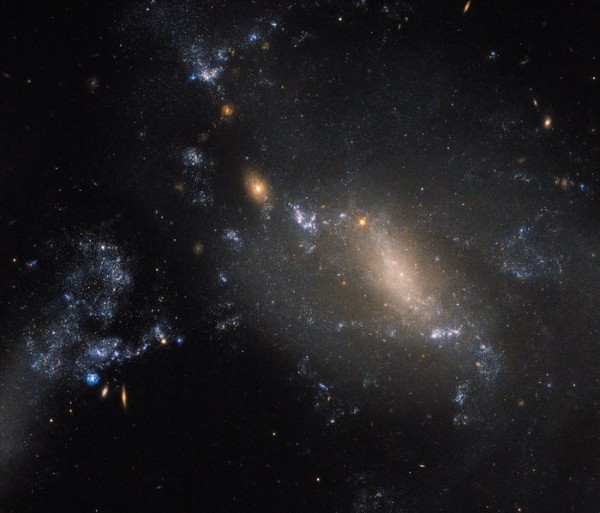By Ana Verayo, | March 26, 2017

Hubble’s Wide Field Camera 3 (WFC3) captured a striking view of two interacting galaxies located some 60 million light-years away
Astronomers have recently captured an incredible image of a two galaxies colliding, appearing to be a violent merger that is tearing each other apart. Thanks to the Hubble Space Telescope, these two galaxies are observed in this unusual state for the first time ever.
Apparently, the two galaxies known as the NGC 3447 together, are using their gravitational forces to interact. They are also located around 60 million light years from Earth, in the constellation Leo where the Hubble Space Telescope zoomed in using its Wide Field Camera 3.
Like Us on Facebook
In this new image, NGC 3447B appears to exude a faint, bluish glow where the smaller region beside it is NGC 3447A. According to the European Space Agency, we are not certain what these galaxies looked like when they were still separate from each other. When they began to tear each other apart, powerful gravitational forces distorted and twisted the galaxies into unusual and unique shapes.
Astronomers describe NGC 3447A as revealing some remnants of the central bar structure along with disturbed spiral arms which are major features of spiral galaxies. Now, astronomers believe that this merger appear to be a spiral galaxy or an irregular galaxy in its original state.
The Hubble Space Telescope has observed numerous galaxies that are being distorted and disrupted during collisions, that can be difficult to categorize. For example, earlier this year, the galaxy NGC 4861 possesses features similar to a spiral galaxy such as rotational velocity however, it appears like an irregular dwarf galaxy.
Another cosmic structure known as IRAS 14348-1447 was also suggested to be made from two spiral galaxies that are rich in cosmic gases that also eventually gravitated towards each other. This gravitational interaction destroyed both of their formations in the process, resulting in a galactic merger.
The Hubble Space Telescope was launched in April 1990 and captured distant galaxies and stars, as far as 13 billion years back. Its predecessor, the James Webb Space Telescope will be launched in October 2018.
-
Use of Coronavirus Pandemic Drones Raises Privacy Concerns: Drones Spread Fear, Local Officials Say

-
Coronavirus Hampers The Delivery Of Lockheed Martin F-35 Stealth Fighters For 2020

-
Instagram Speeds Up Plans to Add Account Memorialization Feature Due to COVID-19 Deaths

-
NASA: Perseverance Plans to Bring 'Mars Rock' to Earth in 2031

-
600 Dead And 3,000 In The Hospital as Iranians Believed Drinking High-Concentrations of Alcohol Can Cure The Coronavirus

-
600 Dead And 3,000 In The Hospital as Iranians Believed Drinking High-Concentrations of Alcohol Can Cure The Coronavirus

-
COVID-19: Doctors, Nurses Use Virtual Reality to Learn New Skills in Treating Coronavirus Patients







